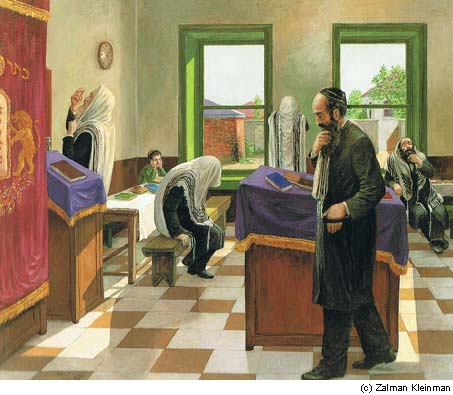By Rabbi Shneur Zalman of Liadi The Alter RebbeTo Understand the Concept of the Tzimtzum 5565-1805 Indented text by the translator
Letter Box
Blown Apart
the world of Emanation (atzilut) is called the world of Rectification. That’s because divine lights there are integrated within complete vessels. Consequently, its vessels are utterly nullified to the lights. The Zohar says of this, “He and His vessels are one.”
Such nullification, however, doesn’t occur within the vessels of the three lower worlds: Creation, Formation, and Action. Called worlds of separation, these aren’t brought into existence directly from divine lights. Rather, broken vessels which fell from the world of Chaos (tohu) are responsible for their creation. This is the only way that entities, which are inherently limited and separated from Divinity, could be brought into existence. Genesis hints, “A river issues from Eden to water the garden, and from there is divided and becomes four headwaters.”
Letter Limiters
How can we understand these types of vessels? Kabbalah teaches that there are three types: inner, intermediate, and outer. They correspond to three kinds of Hebrew letters: letters of thought, letters of speech, and letters of action.
Letters of thought serve as vessels for the light of the faculty of intelligence enclothed within them. They limit intelligence’s light. As a result, its diminished light becomes completely enclothed within thought’s letters. Letters of the faculty of thought are considered the bottommost, or external, aspect of intelligence. They embody a lower state of the original insight—after it has been understood by the combinations of thought’s letters.
Letter Dimensions
Both intelligence and thought are faculties of the soul. They correspond to the sefirot of Wisdom (chochmah) and Understanding (binah). Insights enter the faculty of intelligence from the subconscious, flashing across the mind like lightning. That kernel of insight itself consists of three components: depth, breadth, and length.
The latter is referred to in Kabbalah as “Understanding of Wisdom,” symbolized by the lower tip of the letter yud. Intelligence projects the outermost aspect of an idea down into the vessels of Understanding.
Understanding also possesses depth, breadth, and length. Wisdom’s external insight is seized by Understanding’s letters of thought. These vessel-letters process the insight, turning it into comprehensible information.
Effluence Extractor
The Hebrew word for “letter” illustrates this concept. Letter (oas), is similar to the Aramaic term for “come” (asa). Isaiah spoke Hebrew. Nonetheless, he used the Aramaic word asa, “The watchman said, ‘morning is coming.’ ” He intended to convey the idea that effluence is drawn down: it comes.
Letters of thought likewise manifest the descent of intelligence’s insight. It “comes down here” to become revealed in the faculty of understanding. That’s why every kind of effluence which descends from above to below is called letters.
But why is this concept illustrated by an Aramaic word? It’s known that the Aramaic language is regarded as the bottommost extremity of Hebrew, the holy tongue. Aramaic, current in biblical times, was used to translate, reveal, and explain passages from the original Hebrew. Isaiah’s use of Aramaic to describe the function of letters emphasizes what they really are. Letters of thought are the externality of an insight.
On the other hand, the inner aspect of Wisdom can’t be revealed in the letters of thought; only its external and lower component descends below and is brought into revelation by the letters. This accounts for the etymological origin of the word “letter”—the word “to come,” which is expressed in the “external” Aramaic language.
Word Wreck
How can we understand the concept of the breaking of the vessels? Vessel-letters, Kabbalah explains, became separated one from another. As long as letters were joined to form words, the comprehensive light of intelligence and meaning were enclosed within them. But when letters were separated from each other, the light of intelligence and intention was withdrawn.
For example, consider the word “blessed” (b’ruk). Shining within the sum of its letters is the meaning: “is blessed.” Should the letter beit be removed, however, the remaining letters don’t convey any meaning whatsoever. The same applies if the letter chof is removed: the initial three letters—b-r-u—don’t impart the meaning “blessed.” The significance of the word disappears even more completely when all four letters are isolated from each other.
Nonetheless, a minuscule life force lingers in each disconnected letter. That’s because when they were linked, each letter contributed its own meaning and intention to the word. This demonstrates that even subsequent to their separation, each of the letters that once formed a word retains a tiny residue of that word’s meaning.
References
Nothing is the Same
the Absolute Godhead Himself
Sha’ar HaHakdomot, portal 1, introduction 4;
Shelah, Toldos Adam, chapter Beis HaShem, paragraph 1.
“the Hidden One of all the hidden ones”
The Second Book of the Zohar, page 89, side a;
Tikunei Zohar, introduction, page 17, side a.
“The whole world is filled with His glory”
The Book of Isaiah, chapter 6, verse 3.
“Even darkness obscures not from You, and night shines like …”
The Book of Psalms, chapter 139, verse 12.
Everything is considered as naught before Him.
The First Book of the Zohar, page 11, side b;
Reishis Chochmah, portal HaYirah, chapter 1;
Tanya, Igeret HaKodesh, chapter 25, page 139, side b.
His illumination induces a profound recognition of worthlessness.
Tikunei Zohar, chapter 58, page 92, side b;
Tanya, Igeret HaKodesh, chapter 15, page 124, side a.
Household Name
“The name of heaven”… They routinely make reference to God
Midrash Tanchuma, parshat V’yashav, chapter 8;
Rashi’s commentary on The Book of Genesis, chapter 27, verse 21;
Shelah, Sha’ar Ha’Otiyot, chapter 1, Emes V’emunah, paragraph 16.
“All the hidden things are revealed before You”
Musaf Prayer of Rosh Hashana.
Space Vacuum
He revealed His glory—His Infinite Light
Eitz Chaim, portal 1, section 1.
“There is no place void of Him”
Tikunei Zohar, chapter 57, page 91, side b; ibid., chapter 70, page 122, side b;
Shemot Rabbah, chapter 2, section 5.
Eyeball Empowerment
The soul possesses 10 general powers.
Tikunei Zohar, chapter 13, page 28, side a;
Akedat Yitzchak, portal 52, chapter 4.
each power is directed to its specific locale within the body
Derek Chaim, chapter 2, section 7.
Unseen Ubiquitous
afterwards, a single light beam (kav) of revealed Infinite Light descended
Tikunei Zohar, chapter 5, page 19, side a;
Mevoh Sha’arim, portal 1, section 1, chapter 1.
Life Beam
illustrates the emergence of the beam: A circle is bisected by a line
Otzarot Chaim, portal 1, introduction;
Mevoh Sha’arim, portal 1, section 1, chapter 2;
The First Book of the Zohar, page 171, side b.
The circle represents the interface between infinity and finitude.
Sha’ar HaHakdomot, portal 1, introduction 4;
Emek HaMelech, portal Sha’ashuei HaMelech, chapter 1, page 1, column a.
The “lower” the beam travels, the more diminished the light of its sefirot Mevoh Sha’arim, portal 1, section 1, chapter 2.
reserved for the Future era, when the finite will be fused with the infinite
The Book of Isaiah, chapter 54, verse 2;
Midrash Tanchuma, parshat Tzav, chapter 12;
Pesikta d’Rav Kahana, chapter 12, section 22.







